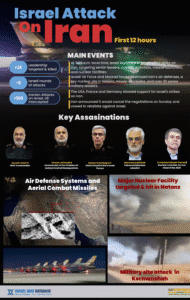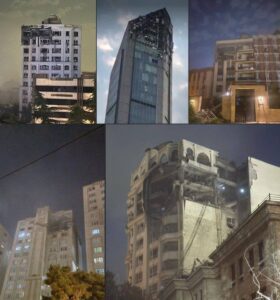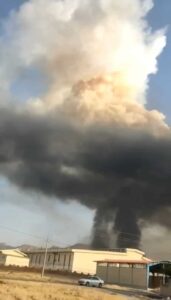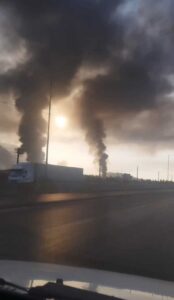Security Snapshot | Updated June 13, 2025 | 15:00PM
In the early morning hours of June 13, 2025, Israel launched an all-out preemptive strike to remove the mounting existential threat posed by Iran’s nuclear program and ballistic missile program. This carefully-planned strike is unprecedented in modern military history, combining the targeted killings of senior officials and scientists, including the top leadership of the Iranian armed forces and IRGC; direct strikes of the main nuclear sites; and the targeting of Iran’s air-defense systems and radar alert systems; among other means. Among those eliminated are IRGC Commander Hossein Salami; Chief of Staff of the Iranian Armed Forces Mohammad Hossein Bagheri; the entirety of the IRGC Air Force high command, including the Air Force commander; and senior advisor to the Leader, Ali Shamkhani. Israeli officials told the press that the Natanz nuclear site was badly damaged.
This operation is still unfolding, with further developments expected in coming hours, days, and weeks.
Iran’s nuclear program has been identified by the United States as a threat to American interests, and both the current and previous administrations, across political lines, asserted that Iran cannot have nuclear weapons. Israel views Iran as the primary existential threat targeting the Jewish State, vowing to prevent Iran from acquiring nuclear weapons. The Iranian regime’s commitment to wage terrorism against Israel, the United States, and the West, coupled with its record-high nuclear activity, has made it the most alarming flashpoint in today’s geopolitical sphere.
This report will lay out the main flashpoints of this operation, and will be continuously updated in accordance with developments on the ground.
War begins: June 13th 03:00AM (Israel Standard Time)
IAF planes in first few rounds: +200
Targets hit: +100
Ammunitions used: +300
Eliminated officials and scientists: Confirmed 10+ | Reported 9+

Background
Iran’s nuclear program has reached new and alarming records in the recent period.
- Non-compliance with its nuclear commitments: The IAEA – International Atomic Energy Agency – has declared Iran in breach of its non-proliferation obligations on June 12, being a party to the NPT. In response, Iran declared the activation of a third enrichment site. Its foreign ministry said it has “no choice but to respond”.
- Refusal to cooperate with the IAEA inspectors: On June 9, the IAEA declared that Iran fails to cooperate with its inspectors, in a way that hampers effective inspections. “Unless and until Iran assists the agency in resolving the outstanding safeguards issues, the Agency will not be in a position to provide assurance that Iran’s nuclear programme is exclusively peaceful,” said IAEA Director General Rafael Grossi.
- Nuclear threshold state: The agency’s recent report from May 2025 painted an alarming picture of the advanced stage of Iran’s nuclear program: 233kg of 60% enriched uranium, which makes Iran capable of manufacturing a sufficient amount of weapons-grade uranium, enriched at 90%, within 2-3 days for its first nuclear device and 1 month for 9 nuclear devices. Iran has also depleted its stock of near 20% enriched uranium, which has a civilian use in research reactors but constitutes an important step toward high-level enrichment levels.
- Dangerously close to weaponization: Israel says Iran has accumulated a sufficient amount of material for 15 nuclear devices, and has made “unprecedented steps” as it relates to “weaponization”, which makes it “close to obtaining nuclear weapons”, per Prime Minister Netanyahu. An IDF spokesperson revealed that “Iranian nuclear scientists secretly conducted experiments to advance all components necessary to build a nuclear weapon.” He added that “this is conclusive proof that the Iranian regime is acting toward obtaining nuclear weapons in the coming period.”
- New underground nuclear facilities: The IAEA and the Institute for Science and International Security (ISIS) have revealed that Iran has developed secret underground nuclear facilities designed to withstand airstrikes and conceal advanced enrichment activities. Satellite imagery and intelligence assessments point to deep excavation sites near Natanz and Fordow, raising serious concerns about undisclosed centrifuge production and uranium enrichment far beyond civilian needs. These sites, mostly hidden from international oversight, suggest deliberate Iranian efforts to maintain a parallel, undeclared nuclear program in violation of its commitments.
- Aggressive rhetoric: Senior Iranian officials have recently issued a series of escalating threats. On November 29, 2024, Iran warned that an IAEA resolution would trigger “immediate technical measures in response.” In April 2025, Ali Shamkhani threatened with the “expulsion of IAEA inspectors and ceasing cooperation” and the “transferring [of] enriched material to safe and undisclosed locations.” In February, President Pezeshkian declared: “If you strike a hundred… we will build a thousand… You can hit the buildings… but not those who build it.” He added, “We will never accept the elimination of our nuclear research.” Foreign Minister Araghchi warned: “If their position is zero enrichment, we will no longer have any talks… we are not joking with anyone.”
- Rejecting peaceful proposals: Since April, US President Donald Trump led bilateral negotiations to attempt to find a peaceful diplomatic solution to address the Iranian nuclear program. A series of talks have been held in Oman and Rome, in which the US confirmed to have submitted several proposals for a deal. Iran’s senior officials flatly rejected any restrictions on uranium enrichment, while President Trump made it clear that the United States will not accept Iran obtaining nuclear weapons, and that there can be “no enrichment”. By June 3, a senior Iranian source confirmed Tehran was preparing to reject the American proposal.
- Iran has also ramped up its ballistic missile program, amounting to a real existential threat on Israel. According to Prime Minister Netanyahu’s statement and to the readout of the IDF Spokesperson’s update, Iran has accumulated thousands of ballistic missiles that can reach every point in Israel, each carrying up to 1 ton of explosives. It is intending to obtain 10,000 such missiles within 3 years and 20,000 within 6 years. “For a country of Israel’s size, such a threat is intolerable,” said Netanyahu.
This comes in the wider context of its multi-front, multidimensional attack by the Iranian regime on Israel as from October 7, 2023. Iran’s new position makes it more dangerous than ever before, with its nuclear program reaching unprecedented levels; while at the same time more vulnerable and exposed than ever before, with its frontal collapse in tatters.
- Israel’s continued effort to erode Iran’s proxy armies and partners around the region in retaliation for the attacks has resulted in the decimation – to varying degrees – of all of its frontal defense. Hamas in Gaza, Hezbollah in Lebanon, the Assad regime in Syria, and the Houthis in Yemen—all suffered severe damage or outright collapsed.
- The war in Gaza is still unfolding, with the IDF continuing its pressure on Hamas to release the remaining 55 Israeli hostages and lay down its arms; Hezbollah’s status in Lebanon was gravely diminished, and future political developments in the current, novel climate will determine the Israel-Lebanon relations in the coming period; the Assad regime in Syria collapsed, making way to Ahmed A-Sharaa’s jihadist leadership, with Israel taking over the Syrian Golan and destroying the vast majority of remaining weaponry in Syria; and Yemen’s Houthi militia was badly hit by Israeli and American strikes and continues to pose a serious though remote threat.
- Israel admitted to striking Iran for the first time in history in October 2024, and reportedly successfully eroded key elements of its air defenses.
- The Iranian regime attacked Israel directly twice, for the first time in history, in April and later in October 2024, launching over 500 projectiles at Israel—ballistic missiles, cruise missiles, and drones.
Key modes of engagement
Israel has admitted acting in the following combined vectors, that form a multiprong effort to target Iran’s soft belly:
- Neutralizing air defenses and radars across all of western Iran, including dozens of radars and ground-to-air missile launchers.
- Targeted killing of senior political and military officials, disrupting the chain of command and taking down key operational figures. An Israeli security source reports that significant intelligence was gathered and surveillance was conducted to expose and target senior figures in Iran’s defense establishment and nuclear program, who were later eliminated. This was part of a broader covert campaign aimed at degrading Iran’s strategic missile infrastructure.
- Targeted killing of senior nuclear scientists, disrupting the accumulated know-how ecosystem and denying Iran quick recovery of its nuclear leadership.
- Airstrikes of key nuclear sites, targeting directly the sites where uranium enrichment and other key components of the nuclear program are undertaken.
- Airstrikes of key ballistic missile sites, targeting directly the sites where missiles are manufactured and stored.
- On-the-ground activity by Mossad operatives: According to Israeli media reports, the Mossad conducted the following activities in Iran:
- Strategic Missile Strikes: Mossad operatives deployed precision-guided weapon systems in central Iran, positioned near Iranian surface-to-air missile (SAM) batteries. These systems were activated in coordination with Israeli Air Force strikes and accurately hit their targets simultaneously.
- Air Defense Suppression: In a separate covert operation, Mossad agents embedded advanced strike systems within civilian vehicles. Upon the launch of the surprise Israeli offensive, these systems were triggered, successfully neutralizing key Iranian air defense installations.
- Drone Offensive on Missile Launchers: Mossad established an internal base of explosive-laden drones, smuggled deep into Iran long before the attack. During the Israeli strike, the drones were launched against surface-to-surface missile launchers at the Esfajabad base near Tehran, eliminating threats to both strategic and civilian targets in Israel.
Five Air-Strike Waves Carried Out in Iran So Far
- Opening salvo – senior figures of the Iranian regime
- Senior nuclear scientists
- Strike on Natanz nuclear facility & SAM batteries in Tehran
- Wave in western Iran targeting surface-to-air and ballistic missiles
- Additional wave in western Iran against the same missile assets
The skies over Iran are completely open to the Israeli Air Force—this is called absolute air superiority, and it is unlikely to change in the coming weeks.
Targeted sites
The IDF released a map showing the main attacked targets:

Military commanders | Nuclear sites | Air-defense systems
Ground-to-ground missiles | Nuclear scientists

The IDF also published an illustration of the attacked air defense systems:


According to Iranian media, various media outlets, and viral videos on social media, it seems that the following sites have been targeted so far:
- The Natanz nuclear site: Iranian state television reported that the Natanz enrichment facility was “hit several times,” showing footage of heavy smoke billowing from the site. Islamic Republic of Iran News Network (IRINN), broadcast footage on June 13, 2025, described as smoke from explosions in Natanz after Israeli strikes.
- Tabriz Military Airbase: Network News of the Islamic Republic’s Voice and Vision confirmed Israeli attacks on targets in Tabriz. Videos received by Iran International (@IranIntl) showed the intensity of explosions in Tabriz, with some Iranian media reporting the Fakouri Airbase as the target.
- A missile production facility in Shiraz was targeted, believed to produce fuel and components for Shahab-1/Scud-B missiles and conduct research and development. Network News of the Islamic Republic’s Voice and Vision confirmed Israeli attacks on targets in Shiraz. The sourcing for Shiraz is less detailed compared to Natanz or Tabriz, with Iranian state TV providing the primary confirmation of attacks in the city.
- The Bakhtaran Missile Base in Kermanshah, a potential launching point for ballistic missiles-Iranian media reported strikes in Kermanshah, as cited by multiple outlets.
- Tehran: Multiple military sites in Tehran were targeted, with residential areas also hit. Damaged structures, including buildings and vehicles, were reported. Key figures, including IRGC chief Hossein Salami and other commanders, were killed. State TV reported residential areas in Tehran were hit, with blasts heard northeast of the capital. Iranian state TV reported the targeting of the IRGC’s Headquarters.
- The Fordow nuclear site was not reported to be hit at this time.
- There were reports of serious disruptions in internet, WhatsApp, and electricity across Iran-Viral videos and posts on social media mentioned disruptions in internet, WhatsApp, and electricity.

Building complexes in Tehran where targeted killings of senior Iranian officials took place | Compliation: Iran News t.me/@hadshotiran

The Natanz Nuclear site | Credit: Open Source Centre, © Airbus Defence and Space

The Shiraz Military Airbase

The Kermanshah Missile Facilities
Source: Iran News t.me/@hadshotiran
Eliminated targets
- Ali Shamkhani, Head of Iran’s nuclear program and senior advisor to the Supreme Leader. Reported by Iran International
Military Leadership hit
- Commander of Khatam al-Anbiya (Emergency Command Center) – Khatam-e-Olam – Ali Rashid. Confirmed Commander of the Iranian regime’s emergency security system. Responsible in routine times for readiness and force-building for war for the Iranian regime. Actively advanced the plan for the destruction of the State of Israel. IRIB and Tasnim News Agency: Confirmed Rashid’s death
- Commander of the Revolutionary Guards – Hossein Salami: Confirmed Responsible for operating Iran’s military power in the Middle East. Took part in suppressing opponents of the Iranian regime. Commanded the ground, air, and naval forces, the “Quds Force” deployed across the Middle East, and internal forces in Iran (“Basij”). Iranian State TV and IRGC related media confirmed his death, he is the most senior Iranian official to have been eliminated, even more senior than Solemini, the former Quds Force Commander, who was eliminated in 2020.
- Chief of Staff of the Armed Forces – Mohammad Hossein Bagheri: Confirmed The highest-ranking military commander in Iran. Holds broad decision-making authority within Iran’s security apparatus. Responsible for coordination among the various Iranian security bodies. Fars News Agency, Mehr News Agency and IRIB
- Commander of the IRGC Air Force – Amir Ali Hajizadeh: Confirmed The central figure in Iran responsible for direct attacks against the State of Israel. Commanded Iran’s missile attacks on Israel in 2024. A highly regarded commander within Iran’s security leadership. Led the attack on Saudi oil facilities in September 2019
- Entire Air force command eliminated together with Commander Hajizadeh, in an underground headquarters to prepare to strike Israel Confirmed
- Taher Pour – Commander of the IRGC Air Force’s Drone Command Confirmed
- Daoud Shikhian – Commander of the IRGC Air Force’s Air Defense Headquarters Confirmed
- Amir Mousavi – Commander of the Iranian Army Reported
- Amir Shahram Irani – Commander of the Iranian Navy Reported
- Ali Reza Pourdastan – Former Commander of the Army Ground Forces Reported
- Kioumars Heydari – Commander of the Army Ground Forces Reported
- Nasirzadeh – Commander of the Air Force Reported

Credit: IDF Spokesperson
Eliminated IRGC Subordinate Commanders
- Mohammad Pakpour – Commander of the IRGC Ground Forces Reported
- Ali Reza Tangsiri – Commander of the IRGC Navy Reported
- Amir Ali Hajizadeh – Commander of the IRGC Aerospace Force Confirmed
- Dawood Shekhiyan – Commander of the IRGC Air Defense Confirmed
- Esmail Qaani – Commander of the IRGC Quds Force Reported
- Ali Reza Soleimani – Commander of the Basij Force Reported
Nuclear scientist
- Dr. Fereydoon Abbasi‑Davani: Confirmed Former head of Iran’s Atomic Energy Organization (2011–2013). Senior nuclear scientist and former member of Parliament He was almost eliminated in 2010 by Israel. Reuters cites Iranian state TV which confirmed his death. Tasnim News Agency (IRGC-affiliated) confirmed Abbasi’s death, describing him as a nuclear scientist and former head of the Atomic Energy Organization.
- Dr. Mohammad Mehdi Tehranchi: Confirmed Prominent nuclear scientist and head of Islamic Azad University in Tehran. IRIB (Islamic Republic of Iran Broadcasting) and Tasnim confirmed Tehranchi’s death in Israeli airstrikes.
- Tasnim reported the killing of at least six scientists.
Targeted Air Defense Systems
According to the IDF, the following air defense systems were destroyed by the IAF and Mossad operatives:
- SA-69 (S-300 Copy): Estimated interception range: 300 km
- SA-68: Estimated interception range: 85 km
- SA-71: Estimated interception range: 24 km
- SA-63: Estimated interception range: 105 km
Israeli media outlets reported on the Mossad activity as follows:
- Mossad advanced preparation: Over recent months, Mossad infiltrated Iran, covertly built forward bases, and stockpiled precision missiles and loitering drones close to Iranian SAM sites.
- Inside-Iran launch: When Israel’s air force opened its broader strike last night, Mossad’s pre-positioned weapons were launched from within Iran, providing an internal “first strike” on Iranian air defences.
- Multi-layered operation: At least three parallel Mossad units—commando teams, vehicle-borne strike kits, and remote-controlled launch sites—were synchronized to cripple Iran’s air-defence network and clear the way for Israeli aircraft.
Aerial Combat Projectiles: Missiles
The following Aerial Combat Missiles used by Iran’s Ballistic Missiles are effective for striking Israel:
- Shahab-3: Effective range ~1,300 km
- Ghadr: Effective range 1,600 km
- Emad: Effective range 1,600–2,500 km
Khorramshahr 1–4: Effective range 2,000–3,000 km - Fateh-1: Effective range 1,400 km
- Haj Qasem: Effective range 1,400 km
- Kheibar Shekan: Effective range 1,450 km
- Sejjil: Effective range up to 2,000 km
*** According to reports, Iran possesses ballistic capabilities that rely heavily on North Korean and Chinese technologies. It is therefore plausible that advanced technologies have been transferred to Iran and integrated into its weapons arsenal — potentially including hypersonic missiles.
Aerial Combat Projectiles: Drones
- Shahed-129: Effective range 1,700 km
Gaza: Effective range 2,000 km - Mohajer: Effective range 2,000 km
- Arash-2: Effective range 2,000 km
- Shahed-136: Effective range 2,500 km
- Kaman-122: Effective range 3,000 km
Iranian retaliation and the Israeli home front
Retaliation
Israel anticipates a significant response by Iran, with Prime Minister Netanyahu advising Israelis to prepare for prolonged stays in safe shelters. The Iranians refer to their planned retaliation as “Operation Assurance of Truth 3.”
So far, Israel says that Iran launched some 100 drones toward Israel, that were reportedly mostly intercepted far from Israeli territory above the skies of Jordan and Saudi Arabia, among others. Jordan announced that its military downed several drones that penetrated its airspace.
Homefront situation in Israel
- Starting at 03:00, immediate changes to the Home Front Command’s defense guidelines took effect. According to the announcement, all regions of the country will shift from a “full activity” status to “essential activity only.” A siren went off to alert Israelis on the new emergency situation, with pop-up emergency messages sent to all mobile phones.
- Some assessments by Israeli officials indicate that the conflict with Iran is expected to last at least two weeks.
- Gatherings in public spaces and work in non-essential locations will be prohibited, in accordance with updated lists issued by the Ministry of Defense.
- Emergency Civilian Order for Continuity of Essential Services: Due to the current security situation and the declaration of a “special state” in the home front, and following consultation with Defense Minister Israel Katz, Labor Minister Yoav Ben-Tzur has signed an emergency order.
- The order permits employees in essential service sectors to continue working within areas under the special home front status, in accordance with Home Front Command safety guidelines.
- This includes sectors such as: water, electricity, fuel, gas, emergency medical care (hospitals, geriatric institutions, dialysis centers, nursing homes), community health services, food supply, welfare institutions, transportation, ports, local authorities, government ministries, and industries supporting the military.
- In case of workforce shortages, the relevant government ministry may request that the Emergency Economy Administration consider issuing mandatory workforce recruitment orders
This order enables the government to mobilize employees as needed to ensure the functioning of critical infrastructure and services during a state of emergency.
- Ben Gurion International Airport has been evacuated and is expected to remain closed for at least three days. All flights to and from Israel have been canceled.
- The Ministry of Health has instructed all hospitals to shift to an exceptional emergency mode, which includes relocating to protected underground facilities and canceling all non-urgent activities.
- All hospitals have been instructed to suspend outpatient and elective services, including non-life-saving surgeries, routine treatments, and clinic visits. Health maintenance organizations (HMOs) and maternal-child health centers will also halt routine services, except for essential activities, primarily dialysis.
- Magen David Adom (MDA) urges the public to donate blood, with priority given to individuals with blood type O.
- All educational institutions have suspended classes. Approximately 2.4 million students, from kindergartens through high schools, have remained at home.
- The public is urged to follow Home Front Command instructions as published through official channels.
- Home Front Command instructions to residents include: after hearing an air raid siren, do not leave the protected shelter after ten minutes unless specifically instructed by the Home Front Command. It is prohibited to post on WhatsApp, Facebook, TikTok, or any other social media platform the locations of missile impacts or interceptions.
- Synagogues to Remain Closed on Shabbat Amid National Emergency.
- 300% Increase in Shoppers; Massive Queues at Retail Chains: There has been a sharp rise in demand for batteries, transistors, and generators, with many customers stocking up on water bottles, milk, and snacks. According to Home Front Command guidelines, Strauss, Tnuva, and Osem factories continue to operate normally, as do supermarket branches and pharmacy chains selling essential products, along with bakeries. Store opening hours remain unchanged, and branches are functioning as usual under the Home Front Command directives. At Carrefour, significant purchase increases were reported: batteries up 1000%, water 500%, dry food 400%, baby products 350%, toilet paper 300%, and dairy products 200%.
- Retail chains will operate in emergency mode, even under fire.

The Middle East skies showing the Iranian airspace empty and the Israeli airspace almost empty
Source: adsbexchange.com
Reactions
Israel
- Prime Minister Benjamin Netanyahu: “This operation will continue for as many days as it takes to remove this threat. For decades, the tyrants of Tehran have brazently, openly, called for Israel’s destruction. They backed up their genodical rhetoric with a program to develop nuclear weapons.” He says Iran has enough enrich uranium for “nine atom bomb”. “In recent months, Iran has taken steps that it has never taken before, steps to weaponize this enriched uranium. If not stopped, Iran could produce a nuclear weapon in a very short time. This is a clear and present danger for Israel’s very survival.” He added, “we cannot leave the threats to the next generation, because if we fail to act now, there will be no next generation.”
- Minister of Defense Katz: “Whoever acts to destroy Israel will be eliminated. Iran will pay increasingly high prices as long as it sticks to its aggression.”
- IDF Chief of General Staff Eyal Zamir: “These are days of decisiveness, we are facing a new chapter in the campaign to ensure our future.” The IDF embarked on a campaign to “attack Iran’s strategic threats toward Israel. We are in a historic and fateful campaign to prevent an existnetial threat.” He added, “it is time, we reached the point of no return. We can no longer wait.”
Iran
- Iranian Leader Ali Khamenei threatened Israel with retaliation: “The Zionist regime has committed a crime in our dear country today at dawn with its satanic, bloodstained hands. That regime should anticipate a severe punishment. By God’s grace, the powerful arm of the Islamic Republic’s Armed Forces won’t let them go unpunished. With this crime, the Zionist regime has prepared for itself a bitter, painful fate, which it will definitely see.”
- Iran’s foreign minister said the strikes were “tantamount to a declaration of war” in a letter to the UN.
- Iran demanded an urgent UN Security Council meeting following the strikes.
United States
- US President Donald Trump: “The Israeli attack on Iran was excellent”. “There’s more to come”. “We gave them a chance and they didn’t take it. They got hit hard, very hard. They got hit about as hard as you’re going to get hit”. Trump told Fox News that he was aware that Israel was going to conduct preemptive strikes on Iran before they happened. The President posted on Truth social that he is urging Iran to take a deal – “just do it”, while threatening Iran not to target the US, saying that “the United States makes the best and most lethal military equipment anywhere in the World, BY FAR, and that Israel has a lot of it, with much more to come – And they know how to use it.” He added, “hey are all DEAD now, and it will only get worse!” and acknowledged there are “more brutal” attacks planned ahead.
Russia
- Putin: “a full-scale war” in the Middle East is possible following Israel’s airstrikes on Iran.
- Kremlin Spokesman Dmitry Peskov: “Russia is concerned about the developments and condemns this sharp escalation.”
- Kosachev, vice-speaker of Russia’s upper house of parliament, made clear that Russia would stand by its ally, Iran.
UK
- Keir Starmer said: “The reports of these strikes are concerning and we urge all parties to step back and reduce tensions urgently. Escalation serves no one in the region. Stability in the Middle East must be the priority and we are engaging partners to de-escalate. Now is the time for restraint, calm and a return to diplomacy.”
Arab world
- Israel reportedly passed a message with strong language to Iraq, Syria, and Lebanon, warning them against intervening. “Any intervention on your part, even the slightest, will entail a disproportionate Israeli retaliation. We will eliminate all of the critical infrastructure in your countries within hours—including ports, power stations, bases, and strategic routes.”
- Lebanon: Sources say that the government will not allow Hezbollah to intervene against Israel on behalf of Iran. Al Arabiya reported that the Lebanese government informed the terror group it will “not tolerate” a response against Israel. “The time when the organization bypassed the state in deciding to go to war is over,” they added. Hezbollah Secretary General Naim Qasem says Hezbollah will “support any Iranian response against Israel,” and a Hezbollah source told Reuters that “Hezbollah will not initiate its own attack on Israel in retaliation for Israel’s strikes.”
- Saudi Arabia, UAE, Jordan all officially condemned Israel’s strike against Iran, but there is a reason to believe that privately, these countries approve of it. Saudi Arabia published a press release: “While the Kingdom condemns these heinous attacks, it affirms that the international community and the Security Council bear a great responsibility to immediately halt this aggression.” The UAE’s foreign minister said in a statement: “The Ministry reaffirmed the UAE’s belief that promoting dialogue, adhering to international law, and respecting the sovereignty of states are the best foundations for resolving current crises.”
- Reza Pahlavi, the Iranian crown prince: “Ali Khamenei, the foolish leader of the anti-Iranian regime of the Islamic Republic, has once again dragged our Iran into a war—a war that belongs neither to Iran nor to the Iranian nation, but to the Islamic Republic and Khamenei.
My message to the army, the police, and the security forces is clear: this regime and its corrupt, incompetent leaders do not value your lives or our Iran. Distance yourselves from them and join the people.
The Iranian nation’s struggle against the destructive Islamic Republic is to reclaim and rebuild Iran. The solution is to topple the Islamic Republic through street protests and nationwide strikes.”
